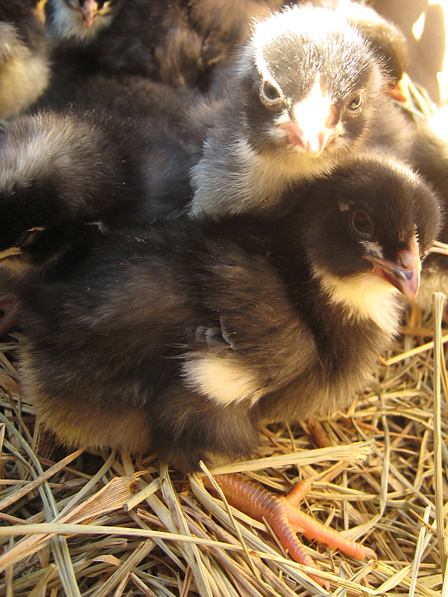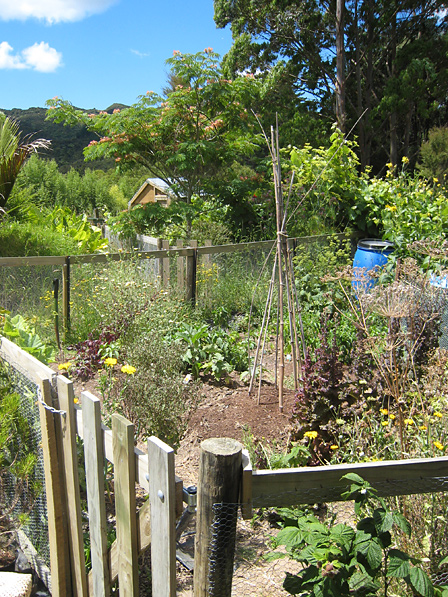We recently bought eighteen two-day-old Barred Rock chicks. They were unsexed, so we will probably wind up with something like half of them turning out to be roosters.
Chickens, used properly, are outstanding creatures for permaculture systems. In addition to devastating the dreaded and fast moving kikuyu grass and other weeds that we have here, the chickens will provide us with manure for fertilizer, eggs and meat. They’re also a source of constant entertainment for young Owen and someone like me who has never kept chickens before.

Barred Rock chicks, two days old
We knew we wanted a dual use breed (good for both eggs and meat). I thought that the Australorp was a good choice. However, we couldn’t find any for sale in the area. We decided to go with what had a good reputation locally, what was available locally and what was immediately available.
We found a local couple who breeds Barred Rock chickens, (and several other varieties or chickens and ducks). I doubt that you’ll find anyone who knows more about chooks than Ken Vincent! He has been breeding and showing his chickens in competitions around the world for decades.
If you’re in the Far North of New Zealand and are looking to get some chickens and or ducks for yourself, contact Ken and Ruth Vincent in Kaitaia. Phone: (09) 408 3929.
So, Becky rang the Vincents and they had the Barred Rock chicks available. We did a bit of research and decided that they seemed like an outstanding choice. They’re very popular in New Zealand and in the U.S. (it’s a U.S. breed)—and probably lots of other places. Barred Rock are good layers, good meat birds, have a generally quiet temperament and rarely go broody.
We knew that making chickens work for us would require a plan and a system. After expending a great deal of money, time and effort (Becky’s dad, my father in law, did most of the building—both of my brothers’ in law helped with the chicken house), we have totally converted our gardens into what I would call an integrated rotational chicken system. The garden is now broken up into individual pens of between fifteen and twenty square metres. All of the pens are connected via a central race. Access to each pen is controlled. The chooks are only able to enter the pen or pens we want them to enter.
Our fences are only a metre high, but we think that will be high enough to contain the chickens for two reasons: First, Barred Rock is a large bird. Second, we’re going to clip their flight feathers. If they do manage to escape, we have a couple of options to remedy the situation. We’ll cross that bridge if we come to it.
As for the layout, our gardens describe an L-shape in our Zone 1 and the main chicken house is located at the angle where the two legs of the L come together. This location is also the gateway area to Zone 2. We are able to send the chickens into Zone 2 as necessary. (See Wikipedia for an overview of permaculture zones, if you’re not familiar with the concept.)

Garden with partitions. The chicken house is visible centre left of frame.
The plan is to move the chickens from pen to pen as required. The chickens will provide tillage (weeding) and manure as they go.
What will we do with all the roosters?
Becky and I like to eat chicken. I really like to eat chicken. Industrial poultry production, however, has put both of us off of it. While it is possible to obtain organic chicken here, I’m not quite sure who is able to afford it. Definitely not us. So, we’re going to go about getting chicken meat in a more traditional manner…
As for what we’re planning on feeding the birds, it’s going to be a variety, most of which they will be finding themselves. We will grow some amaranth for them and possibly other grains that do well here. A major source of protein for them will be maggots. We have an inexhaustible supply of possums here. I have been resiting the urge to grab my rifle and head out into the night lately. I’m letting them build up until our chickens are outside full time. At that point, I will begin trapping and shooting possums at will.
After ripening for about a day (fly strike), the possum carcass will be placed in a 20 litre bucket with 10mm holes drilled around the base. The bucket is suspended above the chickens. People who have done this report that the chickens simply camp out below the bucket, waiting for the next pennies from Heaven to fall. Use biofilter (straw, sawdust or other matter) to keep the smell down.

Farmlet chickens will feast on maggots derived from possum carcasses
While it’s a simple matter to buy bags of feed for chickens, that practice is both expensive and likely to be disrupted in the future (energy shortages, economic collapse, weather related calamity, take your pick). Our goal is to see how little feed we need to buy. Ironically, the possum, a threat to multiple species and habitats in New Zealand, readily converts into maggots that the chickens love to eat.
This is just a general overview. We don’t really know the particulars of how this is going to work, or not work. The permaculture materials I’ve looked at are notably useless when it comes to details on systems like this. (Mollison’s Designers’ Manual has a couple of pictures of one operating in Hawaii.) So, we started with the theory and tried to come up with a plan to make it work.








